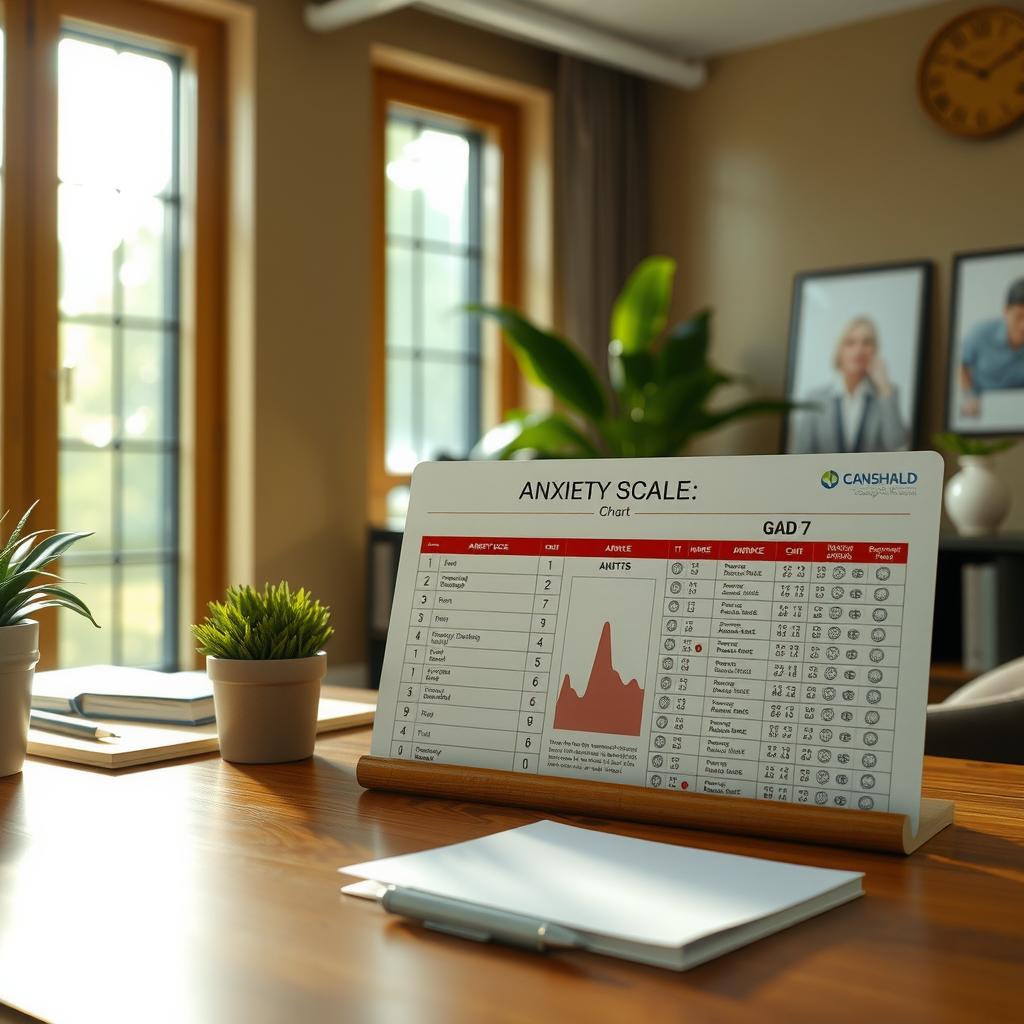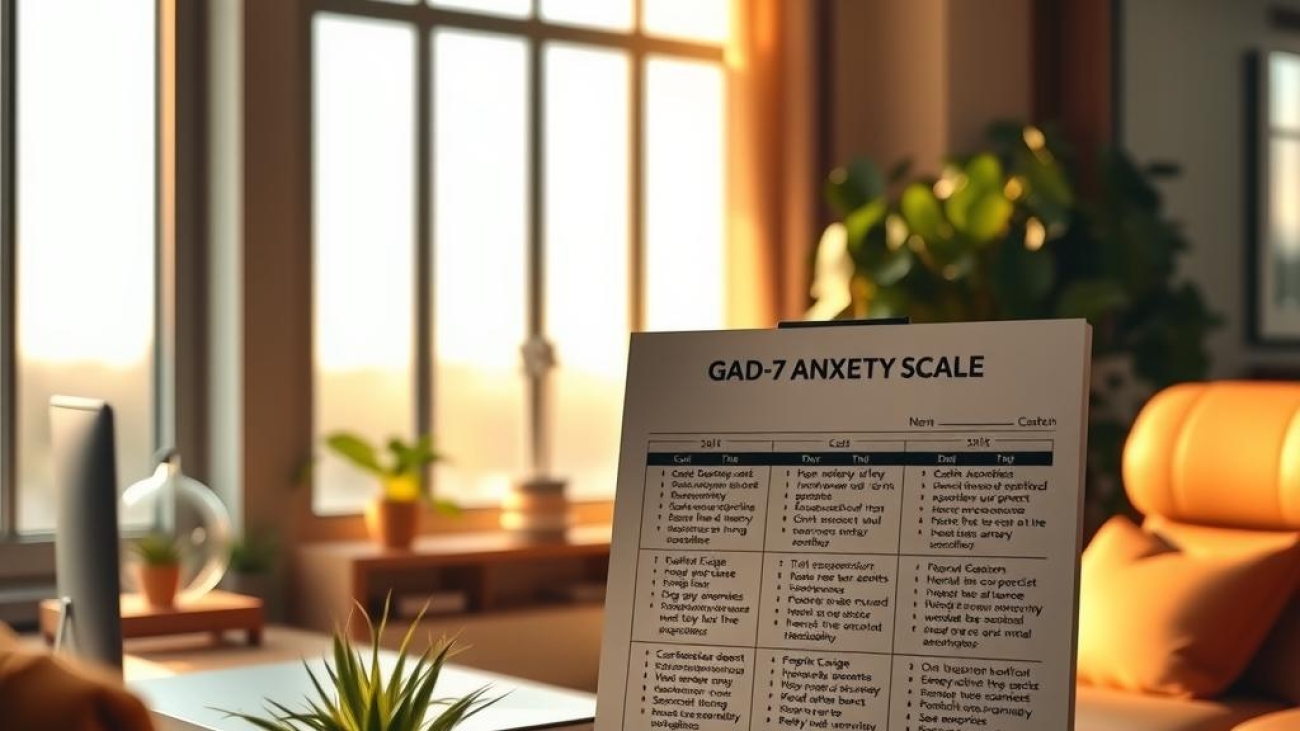Have you ever wondered how anxiety can be quantified or understood in a structured way? For many individuals grappling with anxiety symptoms, navigating mental health assessments can feel daunting. This is where the GAD-7 anxiety scale comes into play, serving as a vital tool for both practitioners and those seeking to understand their mental well-being. The GAD-7, which stands for Generalized Anxiety Disorder 7-item scale, provides an accessible means of evaluating the severity of anxiety through a simple questionnaire that captures various facets of this complex emotion.
Understanding the scores derived from the GAD-7 not only aids in recognizing individual experiences but also contributes significantly to broader psychological evaluations. By interpreting these scores properly, individuals can gain clarity about their mental health status and engage more effectively in discussions with healthcare providers. Moreover, it empowers them to take proactive steps towards managing their anxiety.
As readers delve deeper into this article on understanding anxiety via the GAD-7, they will uncover essential insights on score interpretation that highlight its core value as an assessment tool. From assessing mild symptoms to identifying severe cases requiring immediate intervention, each score tells a story about one’s emotional state and guides potential treatment pathways. With such information at hand, individuals are better equipped to address their concerns comprehensively.
This post aims not just to elucidate how to interpret your scores but also seeks to demystify the underlying principles behind this widely used anxiety scale. In doing so, readers will find valuable knowledge that paves the way toward informed decision-making regarding their mental health journey—ultimately leading them closer to effective coping strategies and support systems tailored specifically for them. So let’s embark on this exploration together and unlock what those numbers truly signify in terms of one’s overall well-being!

Key Insights:
-
Decoding Scores for Improved Understanding: The GAD-7 serves as an invaluable tool in the realm of mental health assessment, allowing individuals to decode their anxiety levels with clarity. By understanding how to interpret these scores, readers can better articulate their experiences and engage in meaningful discussions with healthcare providers. This structured approach not only enhances personal insight but also bridges the communication gap often encountered when addressing mental health concerns.
-
Identifying Anxiety Levels Through Score Thresholds: Each score on the GAD-7 represents a distinct level of anxiety experienced over the preceding two weeks. Recognizing these thresholds—ranging from mild to severe—enables individuals to gauge where they stand on the anxiety scale and encourages proactive measures toward managing distress. These insights into common anxiety symptoms linked to specific scores empower users to take informed steps towards enhancing their emotional well-being.
-
Fostering Resilience Against Anxiety Disorders: A comprehensive understanding of one’s own GAD-7 results is crucial for fostering resilience against challenges posed by anxiety disorders. As readers explore score interpretation further, they may identify patterns that necessitate seeking additional support or implementing effective coping strategies. Embracing this journey through psychological evaluation not only aids in personal growth but also cultivates a sense of empowerment that is essential for navigating life’s complexities associated with anxiety.

Understanding GAD-7: A Tool for Assessing Anxiety
The Importance of the GAD-7 in Mental Health Evaluation
The GAD-7 scale serves as a vital instrument for assessing generalized anxiety disorder (GAD) and understanding anxiety levels among individuals. This seven-item questionnaire is designed to evaluate the severity of anxiety symptoms over the past two weeks, making it an essential tool in both clinical settings and research environments. Each item on the GAD-7 addresses common manifestations of anxiety, such as excessive worry, restlessness, fatigue, difficulty concentrating, irritability, muscle tension, and sleep disturbances. Respondents rate their experiences using a simple Likert scale ranging from 0 (not at all) to 3 (nearly every day), allowing clinicians to quantify the frequency of these symptoms effectively.
Score Interpretation and Its Clinical Relevance
Interpreting scores from the GAD-7 is straightforward yet crucial for accurate psychological evaluation. Total scores range from 0 to 21; higher scores indicate greater severity of anxiety symptoms. Specifically, a score between 5-9 suggests mild anxiety; scores between 10-14 indicate moderate anxiety; while totals above 15 reflect severe levels of distress. This clear scoring system enables healthcare professionals to make informed decisions regarding treatment options tailored to individual needs. Additionally, by regularly administering this assessment during follow-ups or therapy sessions, practitioners can monitor changes in patients’ conditions over time—a critical aspect when evaluating treatment efficacy.
Validity and Reliability of GAD-7 in Research
The validity and reliability of the GAD-7 have been well-documented across diverse populations, contributing significantly to its adoption worldwide as a standardized measure for assessing general mental health status related specifically to anxiety disorders. Studies have demonstrated that it not only correlates strongly with other established instruments but also provides insights into functional impairment associated with heightened levels of worry or fearfulness experienced by individuals suffering from GAD. Given its robust psychometric properties—such as internal consistency measured through Cronbach’s alpha—the GAD-7 stands out as an effective tool for both initial assessments and ongoing evaluations within various therapeutic frameworks.
Enhancing Understanding Anxiety Through Assessment Tools
In conclusion, utilizing tools like the GAD-7 plays a pivotal role in enhancing our understanding of anxiety within mental health contexts. By offering an accessible means for identifying symptomatology associated with generalized anxiety disorder—combined with straightforward scoring interpretations—this scale empowers both patients seeking help and clinicians providing care alike. As mental health awareness continues expanding globally, incorporating such evidence-based assessments fosters better communication about psychological challenges while guiding effective intervention strategies aimed at alleviating suffering caused by chronic anxious thoughts or behaviors.

Understanding the Implications of Your Scores
Decoding Anxiety Through Score Interpretation
Interpreting scores from tools like the GAD-7 provides profound insights into one’s mental health, particularly concerning anxiety. The anxiety scale ranges typically from 0 to 21, with higher scores indicating more severe anxiety symptoms. For instance, a score between 0-4 reflects minimal anxiety; individuals in this range often experience only occasional stressors that may not significantly interfere with their daily lives. Conversely, scores ranging from 5-9 suggest mild anxiety, where symptoms become more noticeable but are manageable for most people. In contrast, those scoring between 10 and 14 are categorized as having moderate anxiety; at this level, individuals may find it challenging to cope effectively with everyday pressures.
Understanding these score interpretations is crucial for recognizing how mental health assessments correlate with real-life experiences of anxiety. Individuals who fall within the moderate category might report difficulties in maintaining focus or experiencing heightened tension during social interactions—common manifestations of elevated anxiety symptoms. Furthermore, those achieving high scores (15 and above) indicate severe levels of distress that can severely impact day-to-day functioning and overall quality of life.
The relationship between the results obtained through the GAD-7, an established psychological evaluation tool specifically designed to assess generalized anxiety disorder (GAD), and personal experiences cannot be overstated. For example, someone scoring over 15 might struggle significantly with work tasks or personal relationships due to overwhelming feelings of worry or panic attacks that disrupt their routines completely.
Moreover, understanding one’s score on the anxiety scale helps pave the way for effective interventions tailored towards alleviating discomfort associated with such high levels of unease. Recognizing these implications enables individuals to seek appropriate support systems—whether through therapy or medication—that can aid in managing their condition effectively.
In essence, translating numerical values into relatable experiences underlines just how vital it is for individuals to engage deeply with their results on tools like the GAD-7. By doing so, they not only gain clarity about their current mental state but also take proactive steps toward improving their well-being by addressing underlying issues tied directly to identified anxieties.
Navigating Mental Health Through Score Insights
Comprehending what your score signifies on instruments such as the GAD-7, becomes instrumental in navigating one’s journey through mental health challenges related to anxiety disorders. As previously mentioned regarding score bands: low scores present a comforting reassurance while higher ones unveil significant concerns needing attention—a critical aspect when discussing individual contexts around understanding anxiety. When analyzing trends across various populations using similar scales worldwide reveals patterns indicative of societal issues influencing collective mental wellness too.
Take note that even subtle shifts downwards within each band signify improvements worth celebrating—often reflecting successful coping strategies being implemented either independently or alongside professional guidance aimed at tackling persistent worries inherent within heightened states marked by disordered thought processes surrounding future uncertainties leading up until today! Each increment serves not merely as data points but rather narratives encapsulating lived realities filled both triumphs & struggles alike!
Furthermore exploring correlations evident upon reviewing previous assessments conducted throughout evolving timeframes further enriches knowledge bases; revealing signs progress made as lifestyle adjustments integrate gradually over longer durations yielding fruitful benefits extending beyond mere statistics alone! Thus engaging earnestly—as encouraged via thoughtful exploration means discovering empowering truths embedded amongst numbers ensuring holistic understandings resonate profoundly intertwined all facets reflectively engaged together harmoniously bridging gaps knowledge fostering resilience ultimately transforming adversity moments into opportunities growth enriching journeys ahead moving forth confidently armed newfound wisdom gleaned accurately amidst changing landscapes forever shifting perceptions regarding self-worth mindfulness whole human experience richer fuller brighter than ever before shining light paths awaiting discovery ahead beckoning all willing listen heed call nurturing spirits flourishing grounded firmly roots deep soil nourishing hearts souls awaken potentials lying dormant breathlessly yearning flourish unfold beautifully throughout lifetimes lived impactful meaningful ways serving greater good world encompassing us all collectively united purposefully onward boldly forward brightly illuminating futures dreams aspirations brightening horizons evermore endlessly expansive possibilities await realization bountiful blessings bestowed endless grace guiding hands shaping destinies woven intricate tapestries interwoven tapestry existence shared community humanity uplift inspire ignite passions thriving vibrantly coursing veins alive pulse rhythm beating heart interconnectedness intrinsic beauty found countless forms expressions myriad wonders waiting embrace simply open eyes behold marvel creation unfolding wondrous artistry crafted divine design universe infinite loving embrace wrap arms around cherish celebrate life cherished moment live fully authentically unapologetically true selves shining brightly illuminate path walk courageously brave adventurers seekers truth seekers joy nestled tenderly sacred spaces hearts hands extended reach gather empower each other uplift nurture love compassion foster unity harmony radiate warmth hope inspire change ripple effects touching lives far wide creating legacies lasting impressions etched memories timeless stories tell generations uniting past present future weaving beautiful complex fabric existence intertwining threads connecting us always eternally grateful sharing journey together seeking understanding connection empathy solidarity kindness abundant everywhere if we choose see feel embrace delicately dance step gracefully flow amid chaos serenity gentleness prevail
Taking Action: Next Steps After Assessment
Proactive Measures for Managing Anxiety Symptoms
Following an effective mental health assessment, such as the GAD-7, individuals can take significant steps toward managing anxiety symptoms and fostering resilience. Understanding anxiety disorders begins with recognizing how they manifest in daily life, often through physiological responses that may include increased heart rate or excessive worry. The GAD-7 serves as a valuable tool in this process by providing a structured way to evaluate the severity of anxiety symptoms through simple questions. A higher score indicates more pronounced issues; thus, making sense of these scores is crucial for developing proactive measures tailored to individual needs. For instance, if someone identifies moderate levels of anxiety on the scale, they might consider cognitive-behavioral therapy (CBT) which has been shown to help restructure negative thought patterns and promote healthier coping mechanisms.
Moreover, lifestyle changes play a pivotal role in alleviating anxiety symptoms. Incorporating regular physical activity can positively impact mental health by releasing endorphins—natural mood lifters that combat stress. Mindfulness practices such as meditation or yoga are additional strategies that have demonstrated effectiveness in reducing feelings associated with anxiety disorders; they encourage present-moment awareness and help mitigate overwhelming thoughts. Engaging socially also fosters resilience against isolation-related anxieties; thus building supportive networks can create robust safety nets during challenging times.
Building Resilience Against Anxiety Disorders
Healthy coping strategies foster long-term emotional well-being beyond immediate symptom management outlined by assessments like the GAD-7. This includes understanding one’s triggers—specific situations or environments that exacerbate feelings of unease—and developing personalized plans to confront them gradually while practicing self-compassion throughout the journey. Furthermore, educating oneself about different types of therapies available provides individuals with empowered choices when seeking support from professionals who specialize in treating anxiety disorders.
Incorporating mindfulness techniques into daily routines not only complements other therapeutic efforts but also enhances overall mental health maintenance post-assessment. Individuals are encouraged to keep track of their feelings using tools like journals or apps designed specifically for tracking emotions over time—the insight gained here may reveal patterns correlating directly with fluctuations noted on assessments like the GAD-7.
Overall, taking decisive action after identifying areas needing attention allows individuals grappling with anxiety disorders not merely to cope but thrive amidst challenges—a testament to personal growth and resilience fueled by informed choices based on comprehensive psychological evaluations such as those provided by tools like the GAD-7 scale.
Understanding and interpreting the GAD-7 anxiety scale scores is crucial for individuals aiming to gain clarity on their mental health. The GAD-7, which stands for Generalized Anxiety Disorder 7-item scale, serves as an effective tool for assessing anxiety symptoms experienced over the past two weeks. Each item on this concise scale provides insight into various aspects of anxiety, including feelings of nervousness, worry, and restlessness.
The score obtained from the GAD-7 can range from 0 to 21, with higher scores indicating greater levels of anxiety. For instance, a total score between 0 to 4 typically suggests minimal or no anxiety symptoms. Individuals in this range may find that they experience occasional stress but are generally able to manage their emotional well-being effectively. Understanding these lower ranges encourages readers who identify here to maintain healthy coping strategies while remaining vigilant about any potential escalation in their feelings of unease.
As one moves up the scoring system—from a mild level (5–9) through moderate (10–14) and severe (15–21)—the implications become more significant concerning daily functioning and overall mental wellness. A score reflecting mild anxiety might signal that an individual could benefit from developing additional coping mechanisms or seeking external support when necessary. Conversely, those within the moderate category may often feel overwhelmed by everyday tasks due to persistent worry or fearfulness; recognizing this threshold through GAD-7 insights can empower individuals to consider professional help sooner rather than later.
Furthermore, understanding how each point correlates with specific anxiety symptoms enhances one’s ability not only to communicate effectively with healthcare providers but also fosters self-awareness regarding personal emotional states. For many individuals confronting challenges related to generalized anxiety disorder, navigating these nuances promotes resilience—allowing them both validation in their experiences and motivation toward proactive measures aimed at managing distress identified through psychological evaluations like the GAD-7.
FAQ:
Q: How do I interpret my GAD-7 score?
A: Your GAD-7 score ranges from 0 to 21; lower scores indicate minimal anxiety while higher scores suggest increasing levels of concern requiring attention.
Q: What should I do if my GAD-7 indicates severe anxiety?
A: If your GAD-7 results reflect severe anxiety (15+), it’s advisable to consult a mental health professional who can provide appropriate support and treatment options tailored for you.
Q: Can I use my GAD-7 results when talking with my doctor?
A: Yes! Sharing your GAD-7 results during medical appointments allows for informed discussions about your mental health assessment and helps guide treatment decisions based on your reported symptoms.

Add a Comment